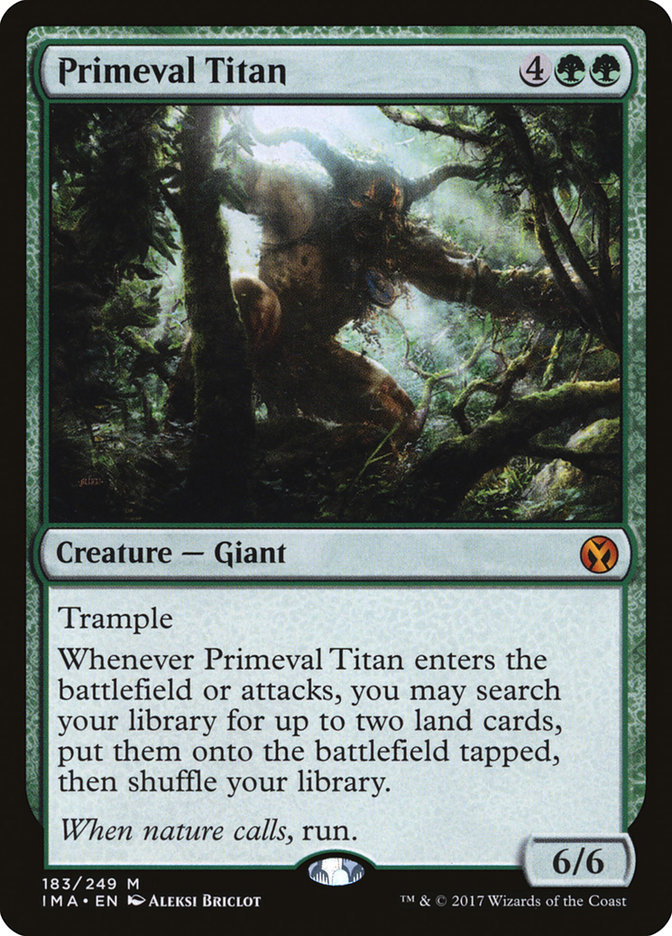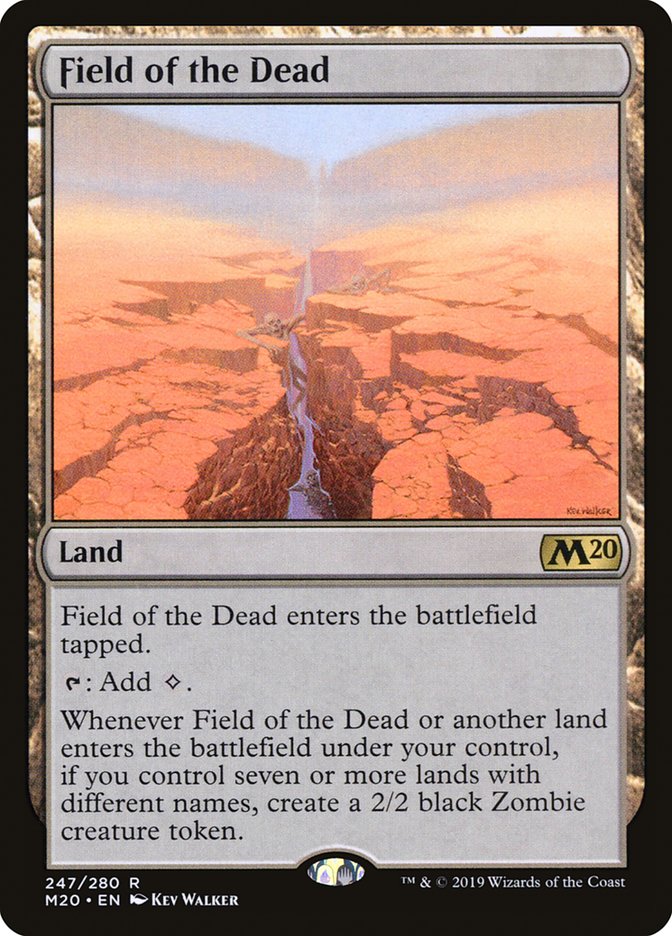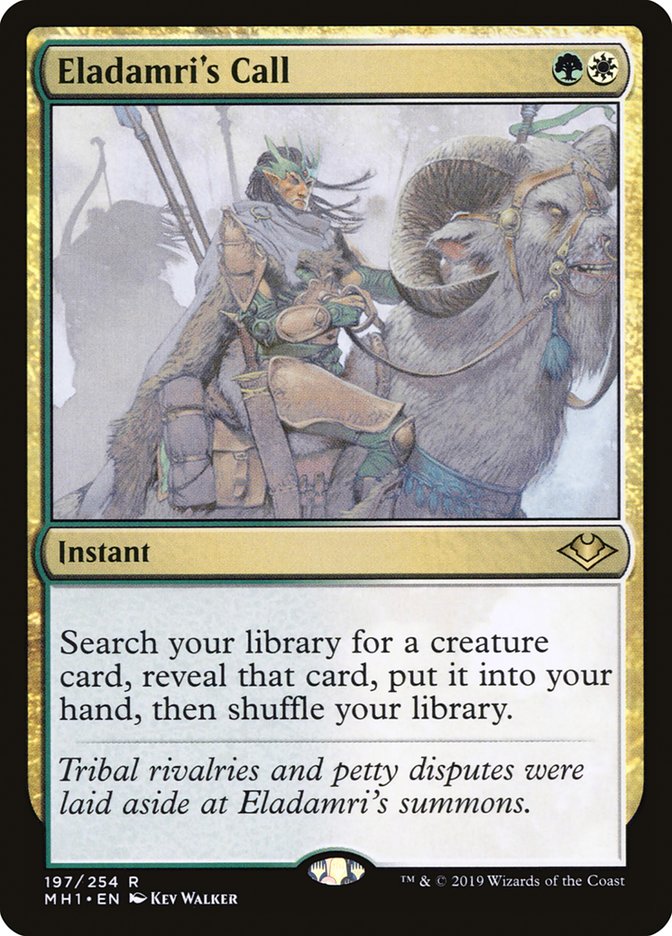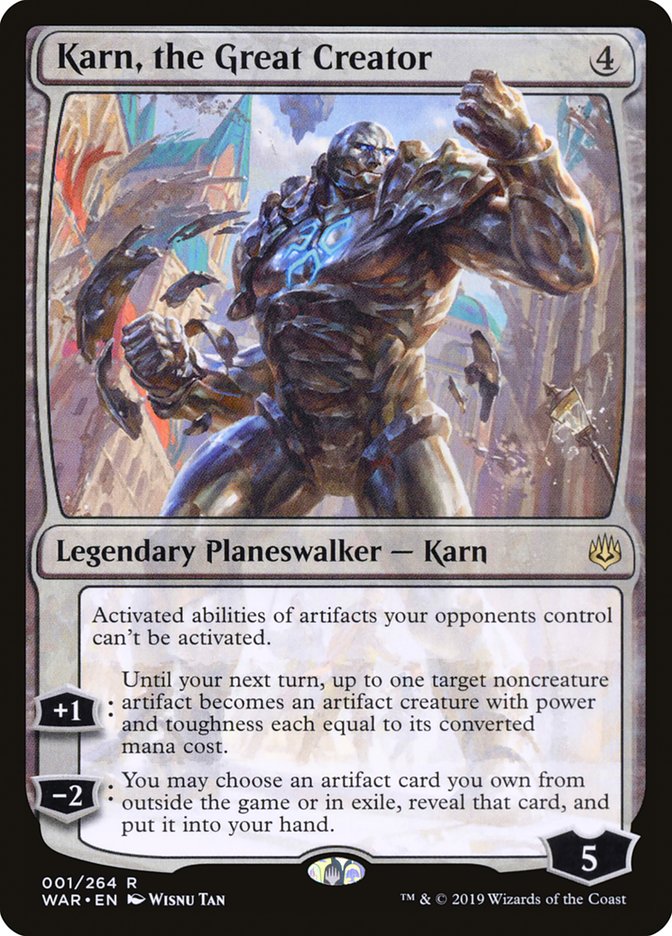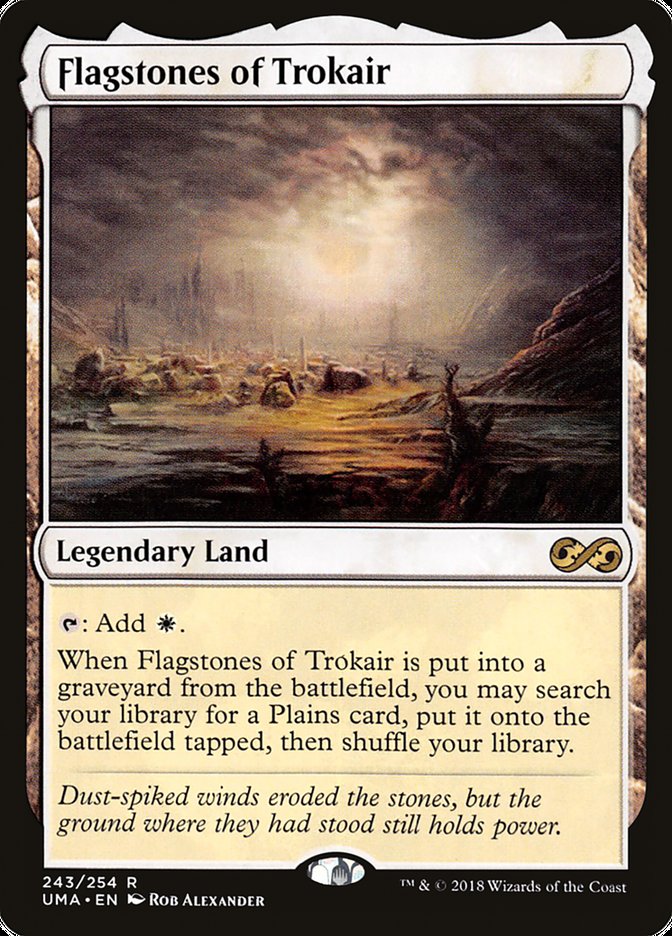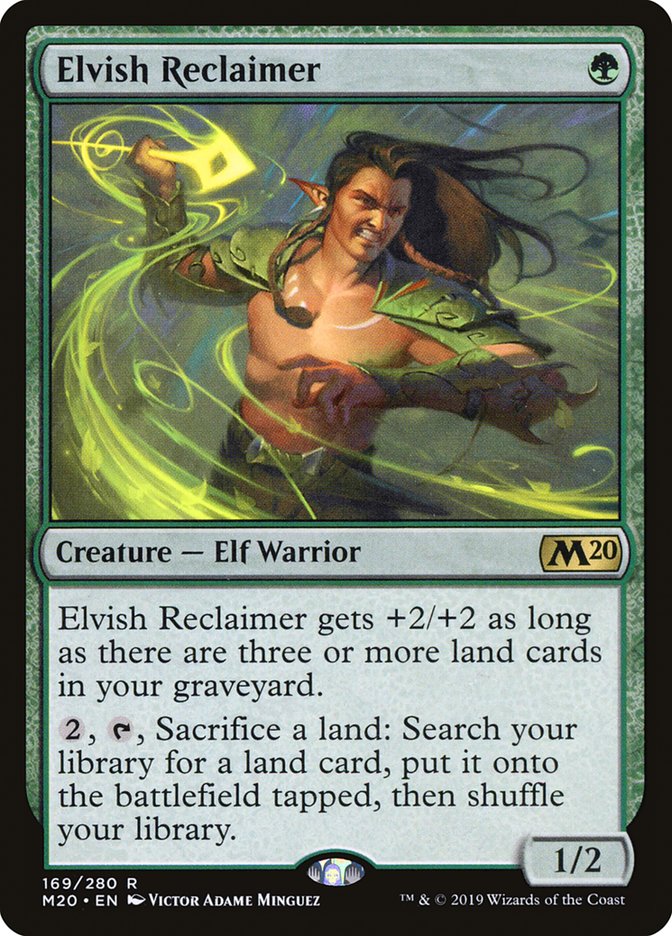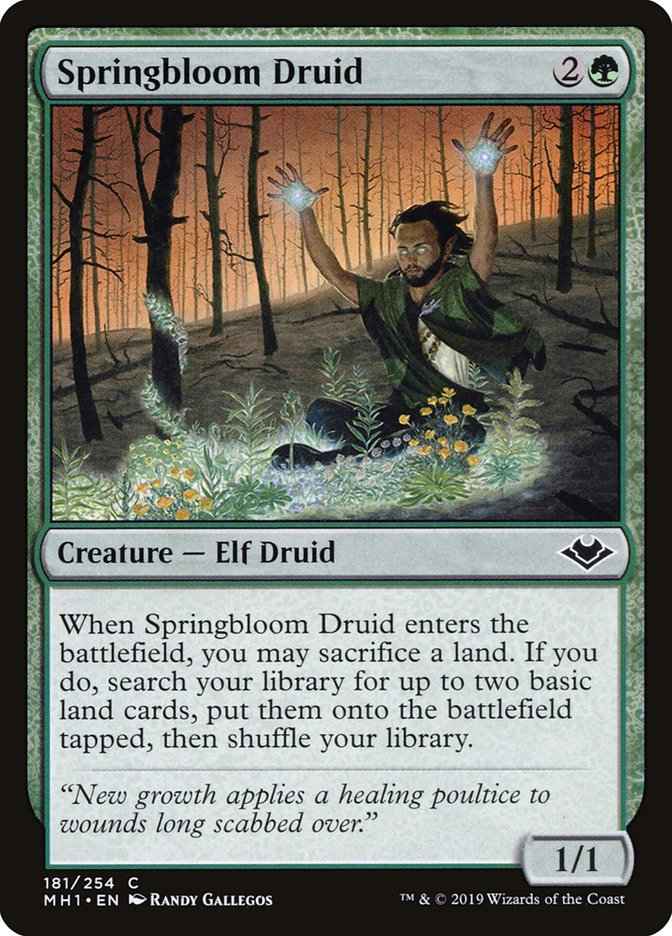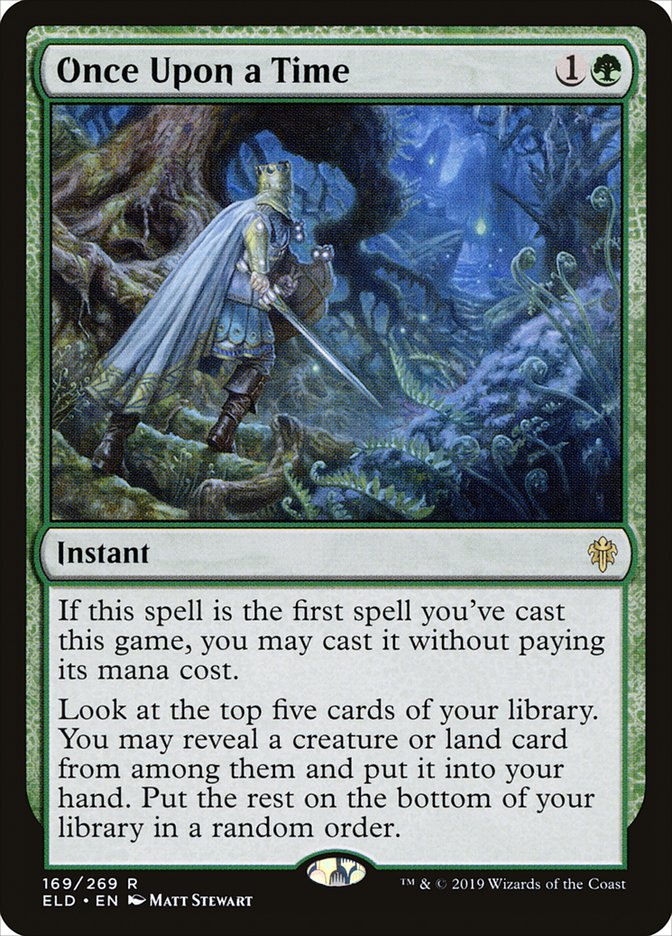Throne of Eldraine
is shaping up to have War of the Spark levels of impact on Modern,
and the most recently previewed powerhouse is Castle Garenbrig. My first
reaction was that this isn’t too exciting – it’s like a Temple of the False
God that only works for creature spells and abilities – but then I
remembered that Primeval Titan exists in Modern, Temple of the False God
doesn’t, and I realized this is a big deal.
This land has very little downside and the advantage of casting Primeval
Titan a turn early. If you’ve ever played a game with Primeval Titan, you
know that casting it a turn early matters, a lot. As in, in Primeval Titan
decks, most of the other cards in the deck are just there to shave a turn
off when you get to cast your first Primeval Titan.
When I
tweeted about this card
, someone replied asking the sequence that lets you cast Primeval Titan a
turn early with this. An example answer to that question is Search for
Tomorrow, Sakura Tribe Elder, Castle Garenbrig, which lets you cast
Primeval Titan on Turn 3 where any other land in Modern wouldn’t. More to
the point, that works with literally any one-mana spell that gives you
extra mana followed by any other spell that gives you extra mana, so it’s
not really a stretch to put this kind of draw together, but more
importantly, I think this question kind of misses the point.
If you imagine that for whatever reason, your ramp spells all cost two
mana, and your plan is to play one on Turn 2 and one on Turn 3, then hit
your fourth land drop and cast Primeval Titan, you might look at this and
think, “I was already casting Primeval Titan on Turn 4, and this doesn’t
let me cast it on Turn 3, so this doesn’t do anything.” That’s not how
Magic works. Sometimes you only draw one ramp spell or only draw three
lands, sometimes your opponent counters a ramp spell. Things don’t always
go according to plan. This land always gets you from four mana to six mana.
It’s always a ramp spell to cast Primeval Titan. Yes, there will
occasionally be draws where that doesn’t let you cast it a turn early, but
most of the time, it will.
If your deck plays Primeval Titan, it should be playing Castle Garenbrig. I
don’t care that it’s not a Mountain and it doesn’t give green mana on Turn
1, and I don’t care that space for lands in Amulet Titan is tight. This
will win you a lot of games by letting you cast Primeval Titan a turn
earlier than you would otherwise be able to. That said, I’m not sure how
many of these you want to play. You don’t want to draw two copies of Castle
Garenbrig, as the aforementioned concerns are real, but they’re just
nowhere near as important as casting your Titan early. I wouldn’t be
shocked if these decks settle on playing only 2-3 copies of Castle
Garenbrig, but it’s very hard for me to believe one would be right and I
can’t see how zero could be.
If you don’t believe me at this point that your existing Primeval Titan
deck should be playing Castle Garenbrig, I don’t think I can say anything
else to convince you, and I’m sure you’ll update when people start winning
with versions of your deck that play it. I’m not especially interested in
working out the exact details of what these established archetypes look
like with Castle Garenbrig. They look roughly the same as they used to, but
they have somewhere between one and four copies each of this and Once Upon
a Time. What I’m interested in is what other Primeval Titan decks should
consider taking advantage of Castle Garenbrig.
When you have access to Castle Garenbrig, the target turn for casting
Primeval Titan shifts from Turn 4 to Turn 3, and you don’t have to jump
through all the hoops of Amulet Titan. This is a strong case for using
creatures to cast Primeval Titan. All you need is something as simple as
two mana creatures living and drawing Castle Garenbrig, and you can cast
Primeval Titan on Turn 3.
Creatures (56)
- 4 Birds of Paradise
- 4 Devoted Druid
- 4 Noble Hierarch
- 4 Knight of the Reliquary
- 1 Acidic Slime
- 4 Lotus Cobra
- 4 Stoneforge Mystic
- 4 Primeval Titan
- 1 Hornet Queen
- 4 Tireless Tracker
- 1 Walking Ballista
- 1 Vizier of Remedies
- 1 Ramunap Excavator
- 1 Shalai, Voice of Plenty
- 1 Knight of Autumn
- 4 Giver of Runes
- 4 Springbloom Druid
- 1 Voracious Hydra
- 4 Elvish Reclaimer
- 4 Gilded Goose
Planeswalkers (4)
Lands (41)
- 4 Wooded Foothills
- 1 Treetop Village
- 4 Windswept Heath
- 1 Snow-Covered Plains
- 2 Snow-Covered Forest
- 3 Temple Garden
- 1 Ghost Quarter
- 4 Flagstones of Trokair
- 1 Horizon Canopy
- 1 Mosswort Bridge
- 1 Windbrisk Heights
- 4 Misty Rainforest
- 4 Verdant Catacombs
- 1 Bojuka Bog
- 1 Sejiri Steppe
- 1 Razorverge Thicket
- 1 Gavony Township
- 1 Canopy Vista
- 1 Field of Ruin
- 2 Field of the Dead
- 2 Castle Garenbrig
Spells (14)

Yes, this deck is over 100 cards. I started by adding all the lands I
wanted, then counted them up and added spells until I had the right ratio
of lands to spells. With so many ways to search for lands, there’s a ton of
value in each extra utility land you can add to the deck, but a serious
drawback to drawing utility lands naturally. This is especially true with
Field of the Dead in particular, which is a horrible land to draw in your
opening hand, but fantastic to find with Primeval Titan. There are enough
good, synergistic cards in Modern that the twelfth best card isn’t
meaningfully worse than the third best card. We’d be making tough choices
and sacrifices choosing exactly which creatures we want to play and which
bullets you want to be able to find with Eladamri’s Call if we stuck to 60
cards.
For a long time, I’ve believed that players as a whole have been too
reluctant to play more than 60 cards. We’ve had enough ways to search
libraries for long enough that we’d get a ton of value out of having extra
options, but most decks with these capabilities have had certain cards they
absolutely want to draw as often as possible holding them back – Birthing
Pod, Devoted Druid, Amulet of Vigor, cards like that. This deck is just a
Selesnya creature pile with access to ways to find utility lands and a
Primeval Titan end game. It might like to find Primeval Titan specifically
slightly more often than it will in this deck, but I don’t think that’s
that big of a deal.
The other huge drawback to playing a deck this large is that your sideboard
cards come up a lot less, so this deck plays a fourteen card Karn, the
Great Creator sideboard. The reason for fourteen cards is that it allows
you to side out one card you don’t want, like Bojuka Bog, without siding
anything in for Games 2 and 3.
Is this build of this deck optimal? There’s roughly a 0% chance that it is,
but there’s a very real chance that it’s better than a 60-card version of
this “archetype.” The other problem with going above 60 cards is that it’s
much harder to make your deck “optimal” when you remove that restriction.
Would this deck be better if I cut ten cards? Maybe. I honestly have no way
of knowing, and no way of knowing which ten cards would be best to cut.
This offers a starting point from which to develop a proof of concept,
tuning from here would involve playing games, and whenever you find
yourself unhappy to draw something, you could just take it out of the deck.
Eventually, you might need to trim a few lands, but worst-case scenario,
cutting a fetch land isn’t the end of the world, and if you want more
lands, and more cards, you can easily add more white fetches.
So, aside from the size, lets go over some things that are going on in this
deck.
First, Flagstones of Trokair is really important, because it means that
Elvish Reclaimer and Springbloom Druid can each put an extra land onto the
battlefield by sacrificing Flagstones, and Elvish Reclaimer can sacrifice
Flagstones to find Flagstones + Temple Garden to build mana.
Our other important payoff lands are Gavony Township, Hideaway lands, and
Field of the Dead, with some extra utility in Ghost Quarter, Field of Ruin,
Sejiri Steppe and Bojuka Bog. Primeval Titan, Elvish Reclaimer, and Knight
of the Reliquary all give us access to these, so we get a lot of value out
of them despite the size of the deck. Once Upon a Time is a straight 10 out
of 10 in this deck, and I’d almost want to play it even if it couldn’t be
cast for free. It finds almost any card in the deck and really helps string
together the ramp and payoff. I’d say drawing fewer of them is a drawback
to playing so many cards, but since you only really want to draw one per
game, even that doesn’t matter much.
I know most people won’t trust the idea of playing a deck with over 100
cards, so let’s take a look at the more conservative approach:
Creatures (28)
- 4 Birds of Paradise
- 4 Devoted Druid
- 4 Noble Hierarch
- 4 Knight of the Reliquary
- 4 Lotus Cobra
- 4 Primeval Titan
- 1 Hornet Queen
- 1 Sigarda, Host of Herons
- 2 Tireless Tracker
Lands (22)
Spells (10)

This version is just dedicated to casting Primeval Titan as early and often
as possible and using it as a Grave Titan with upside by finding two copies
of Field of the Dead.
Once Upon a Time is still amazing in this deck, of course, and between that
and Summoner’s Pact, you should be able to cast Primeval Titan or another
game-winning threat on Turn 3-4 ever game.
Since Field of the Dead came out, I’ve been interested in midrange decks
that use Primeval Titan as the top of their curve rather than dedicated
Primeval Titan ramp decks, like a Jund deck that just uses Primeval Titan
to win the mirror. By essentially turning Primeval Titan into a five-drop
rather than a six-drop, Castle Garenbrig makes playing Primeval Titan
without any ramp spells far more realistic.
Creatures (14)
Planeswalkers (4)
Lands (24)
Spells (18)

Jund is a great place to ask just how far we’re supposed to push Once Upon
a Time. It’s not a combo deck by any stretch, but the card still provides a
great amount of flexibility. There’s not a lot to say about this list –
it’s just Jund with the ability to cast Primeval Titan on Turn 5, playing
fewer copies of Liliana of the Veil because discarding your own cards
doesn’t play well with trying to cast Primeval Titan.
We can go deeper…
Creatures (16)
Lands (17)
Spells (27)

Is this going too deep? Yes. Very much so. And I’m the guy who just
earnestly suggested playing over 100 cards. That said, the Longon Mulligan
rule is pretty good for playing Field of the Dead, and with Once Upon a
Time and Traverse the Ulvenwald available, there’s a real advantage to
having some wild top end that’s completely off plan available in a deck
like this. That said, the concessions of the lands to enable it in Castle
Garenbrig and Field of the Dead are likely a little too extreme.
One more for good measure:
Creatures (24)
- 4 Birds of Paradise
- 4 Noble Hierarch
- 4 Primeval Titan
- 1 Huntmaster of the Fells
- 1 Sigarda, Host of Herons
- 1 Hostage Taker
- 1 Hydroid Krasis
- 2 Niv-Mizzet Reborn
- 1 Arboreal Grazer
- 3 Springbloom Druid
- 2 Golos, Tireless Pilgrim
Planeswalkers (1)
Lands (22)
- 2 Wooded Foothills
- 1 Windswept Heath
- 1 Snow-Covered Plains
- 1 Snow-Covered Mountain
- 1 Snow-Covered Island
- 1 Snow-Covered Forest
- 1 Snow-Covered Swamp
- 1 Overgrown Tomb
- 1 Temple Garden
- 1 Godless Shrine
- 1 Steam Vents
- 1 Stomping Ground
- 1 Breeding Pool
- 2 Misty Rainforest
- 1 Verdant Catacombs
- 3 Field of the Dead
- 2 Castle Garenbrig
Spells (13)

A little bit Niv-Mizzet, a little bit Primeval Titan. The Niv-Mizzets here
are only “good enough” not “Draw five cards,” but I’m not sure how much
that matters – the idea is just to play some big thing that gets value on
Turn 3 every game and go from there.
Long story short, Field of the Dead allows Primeval Titan to be a
game-winning spell without adding a million Mountains to your deck, and
that opens the door to a wide range of decks attempting to include a
Primeval Titan end game, and Castle Garenbrig makes that considerably
faster and easier.



